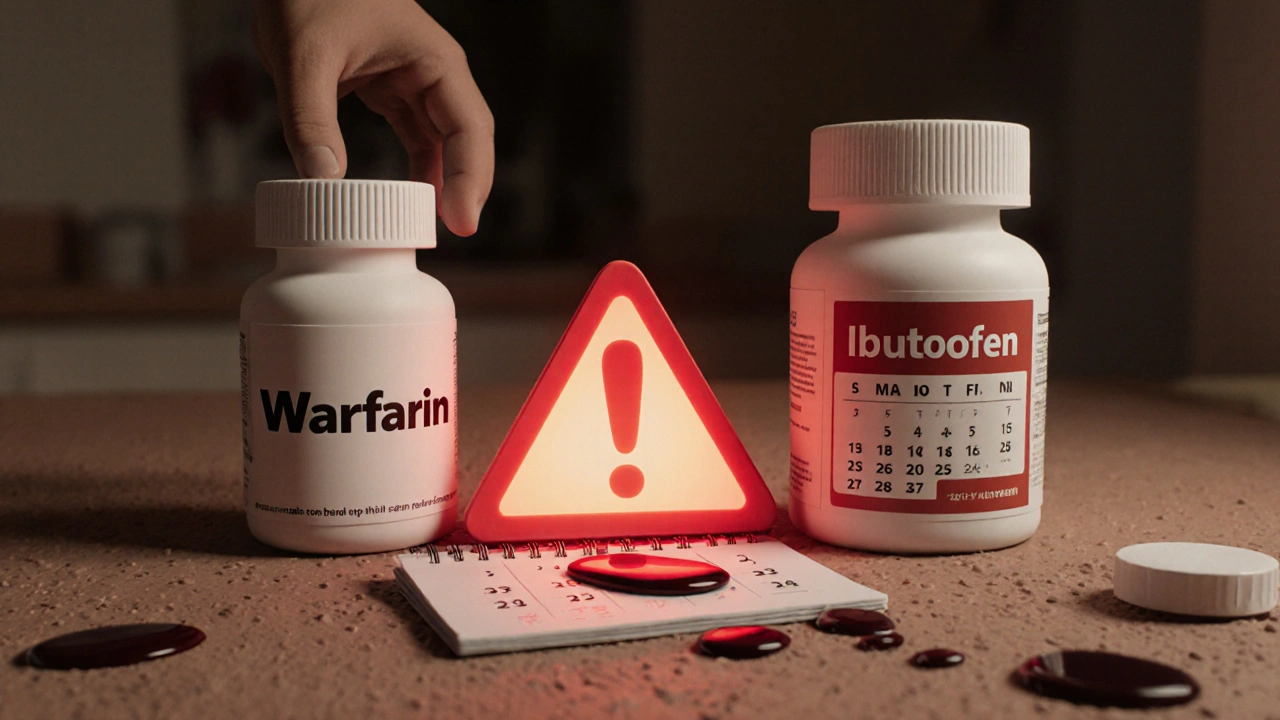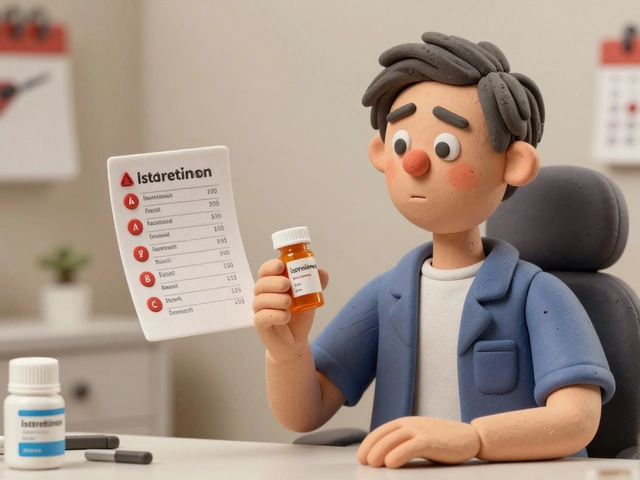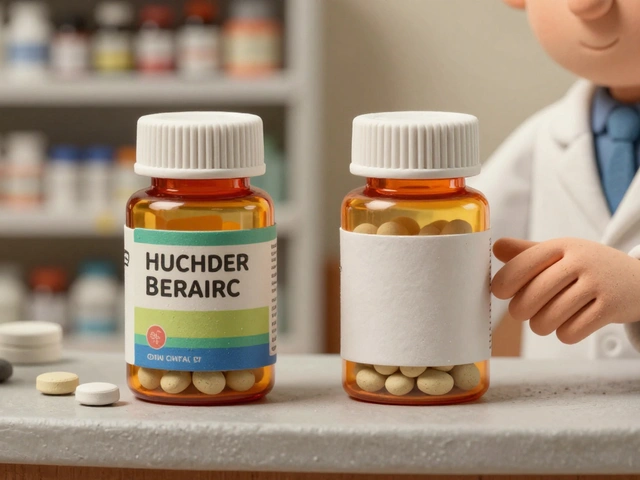Blood Thinner & Pain Reliever Safety Checker
Select your blood thinner and pain reliever to see if they're safe to take together. This tool is based on the latest medical guidelines.
Safety Recommendations
If you're taking a blood thinner like warfarin, apixaban, or rivaroxaban, and you reach for ibuprofen or naproxen to ease a headache or sore knee, you're putting yourself at serious risk. This isn't a rare or theoretical danger - it's a common, well-documented, and often deadly combination. The NSAIDs and blood thinners mix increases your chance of dangerous bleeding by more than double, and many people don’t even realize they’re doing it.
Why This Combination Is So Dangerous
Blood thinners work by stopping your blood from clotting too easily. That’s good if you have atrial fibrillation, a history of clots, or a mechanical heart valve. But it means even small injuries can lead to serious bleeding. NSAIDs - like ibuprofen, naproxen, diclofenac, and even aspirin - do something similar. They block enzymes that help platelets stick together to form clots. When you take both together, your body’s ability to stop bleeding gets hit from two sides. The result? A much higher risk of bleeding in your stomach, brain, kidneys, or even your gums. A 2024 study from Denmark found that people taking NSAIDs with any blood thinner had over twice the risk of serious bleeding compared to those taking only the blood thinner. For some NSAIDs like naproxen, the risk jumped to more than four times higher. Diclofenac? That’s nearly 3.5 times worse. And it’s not just about big accidents - even minor bruising, nosebleeds, or dark stools can signal internal bleeding.Which Blood Thinners Are Most Affected?
Not all blood thinners react the same way to NSAIDs. Warfarin, the older type, is especially risky. When NSAIDs are added, warfarin’s effect becomes stronger, and your INR (a blood test that measures clotting time) can spike dangerously. Studies show warfarin users who take NSAIDs have nearly four times the bleeding risk compared to those who don’t. Newer blood thinners - called DOACs (direct oral anticoagulants) like apixaban, rivaroxaban, dabigatran, and edoxaban - are generally safer overall, but they’re not immune. Even with DOACs, NSAIDs still double or triple your bleeding risk. Apixaban users who take ibuprofen have nearly twice the chance of bleeding. Rivaroxaban users? The risk goes up by 2.1 times. There’s no safe DOAC when paired with an NSAID.Which NSAIDs Are the Worst?
All NSAIDs carry risk, but some are worse than others. Naproxen and diclofenac are the most dangerous - they strongly block platelet function and are linked to the highest bleeding rates. Ibuprofen is a bit less risky, but still dangerous. Even low-dose daily aspirin, often taken for heart protection, is an NSAID and should be avoided unless your doctor specifically says it’s okay. Celecoxib (Celebrex), a COX-2 inhibitor, causes less stomach irritation than other NSAIDs, but it still increases bleeding risk. It’s not a safe alternative - just slightly less bad. The bottom line: if you’re on a blood thinner, avoid all NSAIDs unless your doctor says otherwise.The Only Safe Pain Reliever: Acetaminophen
There is one pain reliever that doesn’t interfere with blood thinners: acetaminophen (Tylenol). At standard doses - up to 3,000 to 4,000 mg per day - it doesn’t affect platelets or clotting. It’s the go-to recommendation from the American Heart Association, the American College of Cardiology, and the European Society of Cardiology. But it’s not perfect. Taking too much acetaminophen can damage your liver, especially if you drink alcohol, have liver disease, or take other medications that affect the liver. That’s why you shouldn’t just max out the dose without checking with your doctor. For most people, 3,250 mg per day is a safe upper limit when on blood thinners.
What About Cold and Flu Meds?
This is where things get tricky. Many over-the-counter cold, flu, and sinus medicines contain NSAIDs - often hidden in the ingredient list. Look for words like “ibuprofen,” “naproxen,” “ketoprofen,” or “indomethacin.” Even “PM” versions of allergy or sleep aids sometimes include NSAIDs. One patient on Reddit shared that after taking a “flu and cold” tablet while on apixaban, he bled for 12 hours after a minor tooth extraction. He didn’t know the tablet had ibuprofen in it. Always read labels. If you’re unsure, ask your pharmacist. Don’t assume “over-the-counter” means “safe with my blood thinner.”Real Stories, Real Risks
Patient reports show this isn’t theoretical. In a 2024 analysis of patient forums, 62% of people on blood thinners admitted to using NSAIDs. Nearly 4 in 10 had bleeding complications: nosebleeds, bruising, vomiting blood, or passing black, tarry stools. One man in Ohio had a brain bleed after taking ibuprofen for a migraine while on warfarin. He survived, but needed a month of rehab. On the flip side, patients who switched to acetaminophen and physical therapy reported better pain control after four weeks than they expected. A 2023 Cleveland Clinic study found 68% of arthritis patients on blood thinners had adequate pain relief without NSAIDs - once they gave acetaminophen and gentle exercise a real try.What Should You Do?
If you’re on a blood thinner and take NSAIDs regularly:- Stop taking them immediately - unless your doctor says otherwise.
- Switch to acetaminophen for pain and fever.
- Check every OTC medicine label before buying or taking it.
- Talk to your doctor about physical therapy, heat/cold therapy, or other non-drug pain options.
- Ask your pharmacist to review all your medications - including supplements - for interactions.

What If You Can’t Stop NSAIDs?
Some people - especially those with severe arthritis - struggle to manage pain without NSAIDs. If your pain is so bad that you can’t walk or sleep, talk to your doctor. There are options:- Use the lowest possible dose of ibuprofen (no more than 400 mg per day) for no longer than three days.
- Take a stomach-protecting drug like pantoprazole (80 mg daily) if you must use an NSAID briefly.
- Get regular INR checks if you’re on warfarin - NSAIDs can push your INR up by 0.8 to 1.2 points, which puts you at high bleeding risk.
Why Doctors Miss This
This interaction is one of the most common medication errors in older adults. Why? Because:- Patients don’t tell doctors they’re taking OTC painkillers.
- Doctors assume patients know NSAIDs are risky - but 47% of patients don’t even know they’re contraindicated.
- Electronic health records often don’t block this combo - only 38% of U.S. hospitals have systems that stop prescriptions when this mix is detected.
- Many patients get NSAIDs from dentists or urgent care clinics who don’t know about their blood thinner.
The Bigger Picture
This isn’t just about one bad drug combo. It’s about how we treat pain in older adults. Over 12 million Americans over 65 are on blood thinners. Most also have arthritis. The system pushes pills - not movement, not therapy, not education. The result? 87,000 emergency room visits and 24,000 hospitalizations every year in the U.S. alone - all from a preventable mix. The annual cost? Over $1.2 billion. New rules are coming. In 2025, the American Heart Association will likely strengthen warnings. The FDA is testing AI tools that flag this combination at the pharmacy counter. Some hospitals are already reducing NSAID use by 37% with better tracking and pharmacist-led reviews.What’s Next?
You don’t have to live in pain. You don’t have to risk bleeding. The tools are there:- Acetaminophen for pain and fever
- Physical therapy for joint pain
- Heat wraps, ice packs, and gentle stretching
- Topical creams like capsaicin or menthol
Can I take ibuprofen with warfarin?
No. Taking ibuprofen with warfarin significantly increases your risk of dangerous bleeding, including in the stomach and brain. Warfarin’s effect becomes stronger when combined with NSAIDs, causing your INR to rise unpredictably. Even low doses of ibuprofen are risky. Use acetaminophen instead.
Is aspirin safe with blood thinners?
Aspirin is an NSAID and should not be taken with blood thinners unless your doctor specifically prescribes it. Even low-dose aspirin (81 mg) increases bleeding risk by interfering with platelet function. If you’re on a blood thinner for atrial fibrillation or a clot, adding aspirin doesn’t add protection - it only adds danger.
What pain reliever is safe with apixaban?
Acetaminophen (Tylenol) is the safest choice for pain relief with apixaban. At doses up to 3,000-4,000 mg per day, it doesn’t affect clotting or increase bleeding risk. Avoid all NSAIDs, including ibuprofen, naproxen, and celecoxib. Always check OTC labels - many cold and flu medicines contain hidden NSAIDs.
Can I take NSAIDs occasionally if I’m on a blood thinner?
Occasional use is still risky. Even a single dose of naproxen or diclofenac can trigger bleeding. If you absolutely must use an NSAID, limit it to the lowest dose (like ibuprofen 200 mg) for no more than three days, and only with your doctor’s approval. Always take a stomach protector like pantoprazole if you do. But the safest choice is to avoid them completely.
Do all blood thinners react the same with NSAIDs?
No. Warfarin has the highest bleeding risk when combined with NSAIDs - nearly four times higher. DOACs like apixaban and rivaroxaban have lower absolute risk, but NSAIDs still double or triple bleeding chances. No blood thinner is safe with NSAIDs. The difference is in degree, not safety.
What should I do if I accidentally took ibuprofen with my blood thinner?
If you took one dose of ibuprofen or another NSAID, monitor for signs of bleeding: unusual bruising, nosebleeds, dark or tarry stools, vomiting blood, severe headaches, or dizziness. Call your doctor immediately. If you’re on warfarin, you may need an INR check sooner than scheduled. Don’t wait for symptoms - bleeding can be silent until it’s serious.
Are there natural alternatives to NSAIDs for joint pain?
Yes. Physical therapy, weight management, heat and cold therapy, and topical creams with capsaicin or menthol can help. Some studies show glucosamine and chondroitin may reduce arthritis pain over time, though results vary. Always talk to your doctor before starting supplements - some can interact with blood thinners too.







Denise Cauchon
OMG I JUST REALIZED I’VE BEEN TAKING IBUPROFEN WITH MY WARFARIN FOR 3 YEARS 😱 My gums bleed every time I brush and I thought it was just ‘aging’-turns out I’m basically a walking time bomb. THANK YOU FOR THIS POST. I’m switching to Tylenol TODAY. Also, who else is mad that pharmacies don’t warn you? 🤬
Andrea Johnston
Of course the system is designed to kill us slowly. Big Pharma doesn’t want you to know acetaminophen exists because it’s cheap, generic, and doesn’t require a 12-step approval process. Meanwhile, they’re selling you $200/month ‘natural’ joint creams that do nothing. Wake up, people. This isn’t medical advice-it’s corporate negligence wrapped in a white coat.
Scott Macfadyen
I’m 68, on rivaroxaban for AFib, and I used to pop naproxen like candy for my knees. After reading this, I went to my pharmacist and asked about the cold meds I’ve been buying. Turns out my ‘flu & sinus’ tablet had ibuprofen in it. I threw them all out. Now I use heat wraps and ice. It’s not magic, but I’m not bleeding out either. Stay smart.
Chloe Sevigny
The epistemological failure here is not merely pharmacological-it is systemic. The conflation of symptom management with therapeutic intervention, coupled with the commodification of analgesia, renders the patient an unwitting participant in their own iatrogenesis. The FDA’s passive regulatory posture and the absence of real-time EHR interdiction protocols constitute a failure of the precautionary principle in clinical governance. Acetaminophen, while pharmacologically inert with respect to coagulation, remains an imperfect solution within a broken paradigm.
Victoria Malloy
Thank you for sharing this. I was so scared after my dad had a bleed last year, and I didn’t know why. This makes so much sense now. I’m going to print this out and give it to my mom. She’s on warfarin and still grabs Advil like it’s candy. You’re helping people. 💙
Gizela Cardoso
I switched to Tylenol last year after my cardiologist told me to. Honestly? My pain didn’t get worse. I started doing yoga twice a week and using a heating pad at night. It’s not perfect, but I sleep better and I’m not scared every time I get a headache. Small changes, big results. You’ve got this.
Alex Czartoryski
Y’all are acting like this is some secret. I’ve been a pharmacist for 18 years. Every single day, someone walks in asking if they can take Motrin with their blood thinner. I have to say NO. 87% of the time they look at me like I’m speaking Mandarin. Then they go to Walmart and buy the same damn thing in a different bottle. The problem isn’t the meds-it’s the ignorance. And the labels? They’re written by lawyers, not humans.
Timothy Uchechukwu
Why are you all so scared? In Nigeria we just take what works. My cousin took ibuprofen with warfarin for 5 years and he’s fine. Maybe your doctors are too scared to let you live. Why do you trust Western medicine more than your own body? Maybe the real danger is trusting pills over nature.
Samkelo Bodwana
While I understand the urgency of this warning, I think we must also acknowledge the lived reality of chronic pain. For many elderly patients, especially in underserved communities, acetaminophen simply doesn’t cut it. The real issue isn’t the NSAID-blood thinner interaction-it’s the lack of access to physical therapy, pain specialists, and holistic care. We’re telling people to stop one drug and giving them nothing else. That’s not safety-that’s abandonment. The system failed them long before they reached the pharmacy counter.
Emily Entwistle
THIS. IS. EVERYTHING. 🙌 I’m a nurse and I see this every single day. One lady came in with a GI bleed after taking ‘just one’ Aleve for her back. She didn’t even know it was an NSAID. I showed her the label and she cried. Please, please read the fine print. And if you’re unsure-ASK. No question is dumb when your life’s on the line. 💕
Duncan Prowel
It is worth noting that the pharmacokinetic interaction between NSAIDs and DOACs is not fully elucidated in all clinical contexts. While platelet inhibition is a well-documented mechanism, the role of renal clearance modulation-particularly with rivaroxaban and apixaban-remains under-researched. The 2024 Danish cohort study, while robust, does not account for genetic polymorphisms in CYP3A4 or P-glycoprotein expression, which may significantly modulate bleeding risk. Further stratification is warranted.
Bruce Bain
My grandma takes blood thinner. She hates Tylenol. Says it doesn’t do anything. So I got her those little pain patches you stick on your knee. She says they help. Also, we started walking around the block every day. She says her knees feel better than in years. Not magic. Just movement. And she didn’t need to take a single pill.
kim pu
so like… i took naproxen once for my period and then i was like ‘wait i’m on apixaban??’ and i just panicked and cried in the bathroom. then i googled it and almost called 911. i’m fine but now i’m scared of EVERYTHING. even the word ‘ibuprofen’ makes me jump. can we get a pill that just… stops hurting without trying to kill us??
malik recoba
i just wanna say thank you for writing this. my dad had a brain bleed last year and they said it was from the ibuprofen he took for his back. he’s okay now but he’s scared to even take tylenol. i showed him this and he cried. we’re gonna go see his doc next week. you saved his life without even knowing it. thank you.